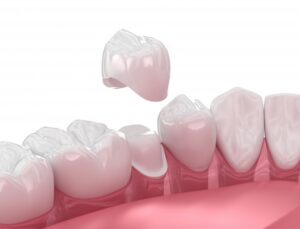
If your tooth has suffered significant damage or decay, then one of the best ways to treat it is with a
dental crown. Not only will this restoration keep your underlying tooth safe, but it can even improve its strength and longevity. Before undergoing the treatment, here’s a brief look at the step-by-step process for getting your customized dental cap.
Treating Damages
To get a dental crown, your dentist will first need to fix any complications with your tooth. This will involve removing any damaged or decayed portions with specific tools. Beforehand, your team will numb your mouth with a local anesthetic so that you’re as comfortable as possible. This allows you to be pain-free while your dentist prepares your tooth for your future restoration.
Cleaning the Tooth
Once your dentist has removed the damaged pieces, they will clean and sanitize your tooth. There will often be a space after they’ve treated it, which means it’ll also be exposed to bacteria. That’s why they’ll thoroughly disinfect the area so that you have a fresh start with your brand-new dental cap.
Filling
After your dentist has sanitized your prepared tooth, they will move on to filling the space with a tooth-colored material. This usually consists of composite resin and is a popular choice due to its durability and natural look. With this material, your tooth will be better protected against bacteria and infection that could occur underneath the dental cap.
Smoothing
The last part of the preparation process involves smoothing down the tooth surface. In some cases, a damaged or decayed tooth may have sharp or jagged edges, which can be harmful to your tongue or cheeks. To avoid any potential discomfort, your dentist will numb your mouth with local anesthesia and then carefully shave any pointed areas so that your underlying tooth is as smooth as possible.
Placing the Crown
Your team will take impressions of your prepared tooth and send these to a lab so that they can construct your dental crowns. While you wait, you’ll need to wear a temporary crown to protect the exposed tooth. Once your restoration is complete, you’ll return and have them permanently fitted. Your dentist will then confirm that your bite is correct and that you’re satisfied with your results before sending you on your way to enjoy your brand-new smile. With proper care, you should be able to make the most of your restoration for many years to come!
About the Author
Dr. Renu Michelsen has well over two decades of experience in the dental field, and she’s seeking new ways to improve her knowledge and skills. She offers a wide range of services, including completely personalized dental crowns to renew damaged or decayed teeth. Want to strengthen a weakened tooth?
Click here or give our team a call today at
714-492-1169.
 If your tooth has suffered significant damage or decay, then one of the best ways to treat it is with a dental crown. Not only will this restoration keep your underlying tooth safe, but it can even improve its strength and longevity. Before undergoing the treatment, here’s a brief look at the step-by-step process for getting your customized dental cap.
If your tooth has suffered significant damage or decay, then one of the best ways to treat it is with a dental crown. Not only will this restoration keep your underlying tooth safe, but it can even improve its strength and longevity. Before undergoing the treatment, here’s a brief look at the step-by-step process for getting your customized dental cap.  If your tooth has suffered significant damage or decay, then one of the best ways to treat it is with a dental crown. Not only will this restoration keep your underlying tooth safe, but it can even improve its strength and longevity. Before undergoing the treatment, here’s a brief look at the step-by-step process for getting your customized dental cap.
If your tooth has suffered significant damage or decay, then one of the best ways to treat it is with a dental crown. Not only will this restoration keep your underlying tooth safe, but it can even improve its strength and longevity. Before undergoing the treatment, here’s a brief look at the step-by-step process for getting your customized dental cap.  Request
Request